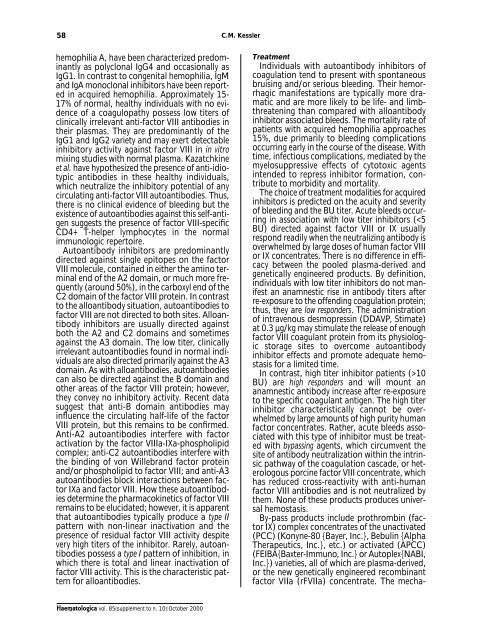Haematologica 2000;85:supplement to no. 10 - Supplements ...
Haematologica 2000;85:supplement to no. 10 - Supplements ...
Haematologica 2000;85:supplement to no. 10 - Supplements ...
Create successful ePaper yourself
Turn your PDF publications into a flip-book with our unique Google optimized e-Paper software.
58<br />
C.M. Kessler<br />
hemophilia A, have been characterized predominantly<br />
as polyclonal IgG4 and occasionally as<br />
IgG1. In contrast <strong>to</strong> congenital hemophilia, IgM<br />
and IgA mo<strong>no</strong>clonal inhibi<strong>to</strong>rs have been reported<br />
in acquired hemophilia. Approximately 15-<br />
17% of <strong>no</strong>rmal, healthy individuals with <strong>no</strong> evidence<br />
of a coagulopathy possess low titers of<br />
clinically irrelevant anti-fac<strong>to</strong>r VIII antibodies in<br />
their plasmas. They are predominantly of the<br />
IgG1 and IgG2 variety and may exert detectable<br />
inhibi<strong>to</strong>ry activity against fac<strong>to</strong>r VIII in in vitro<br />
mixing studies with <strong>no</strong>rmal plasma. Kazatchkine<br />
et al. have hypothesized the presence of anti-idiotypic<br />
antibodies in these healthy individuals,<br />
which neutralize the inhibi<strong>to</strong>ry potential of any<br />
circulating anti-fac<strong>to</strong>r VIII au<strong>to</strong>antibodies. Thus,<br />
there is <strong>no</strong> clinical evidence of bleeding but the<br />
existence of au<strong>to</strong>antibodies against this self-antigen<br />
suggests the presence of fac<strong>to</strong>r VIII-specific<br />
CD4+ T-helper lymphocytes in the <strong>no</strong>rmal<br />
immu<strong>no</strong>logic reper<strong>to</strong>ire.<br />
Au<strong>to</strong>antibody inhibi<strong>to</strong>rs are predominantly<br />
directed against single epi<strong>to</strong>pes on the fac<strong>to</strong>r<br />
VIII molecule, contained in either the ami<strong>no</strong> terminal<br />
end of the A2 domain, or much more frequently<br />
(around 50%), in the carboxyl end of the<br />
C2 domain of the fac<strong>to</strong>r VIII protein. In contrast<br />
<strong>to</strong> the alloantibody situation, au<strong>to</strong>antibodies <strong>to</strong><br />
fac<strong>to</strong>r VIII are <strong>no</strong>t directed <strong>to</strong> both sites. Alloantibody<br />
inhibi<strong>to</strong>rs are usually directed against<br />
both the A2 and C2 domains and sometimes<br />
against the A3 domain. The low titer, clinically<br />
irrelevant au<strong>to</strong>antibodies found in <strong>no</strong>rmal individuals<br />
are also directed primarily against the A3<br />
domain. As with alloantibodies, au<strong>to</strong>antibodies<br />
can also be directed against the B domain and<br />
other areas of the fac<strong>to</strong>r VIII protein; however,<br />
they convey <strong>no</strong> inhibi<strong>to</strong>ry activity. Recent data<br />
suggest that anti-B domain antibodies may<br />
influence the circulating half-life of the fac<strong>to</strong>r<br />
VIII protein, but this remains <strong>to</strong> be confirmed.<br />
Anti-A2 au<strong>to</strong>antibodies interfere with fac<strong>to</strong>r<br />
activation by the fac<strong>to</strong>r VIIIa-IXa-phospholipid<br />
complex; anti-C2 au<strong>to</strong>antibodies interfere with<br />
the binding of von Willebrand fac<strong>to</strong>r protein<br />
and/or phospholipid <strong>to</strong> fac<strong>to</strong>r VIII; and anti-A3<br />
au<strong>to</strong>antibodies block interactions between fac<strong>to</strong>r<br />
IXa and fac<strong>to</strong>r VIII. How these au<strong>to</strong>antibodies<br />
determine the pharmacokinetics of fac<strong>to</strong>r VIII<br />
remains <strong>to</strong> be elucidated; however, it is apparent<br />
that au<strong>to</strong>antibodies typically produce a type II<br />
pattern with <strong>no</strong>n-linear inactivation and the<br />
presence of residual fac<strong>to</strong>r VIII activity despite<br />
very high titers of the inhibi<strong>to</strong>r. Rarely, au<strong>to</strong>antibodies<br />
possess a type I pattern of inhibition, in<br />
which there is <strong>to</strong>tal and linear inactivation of<br />
fac<strong>to</strong>r VIII activity. This is the characteristic pattern<br />
for alloantibodies.<br />
Treatment<br />
Individuals with au<strong>to</strong>antibody inhibi<strong>to</strong>rs of<br />
coagulation tend <strong>to</strong> present with spontaneous<br />
bruising and/or serious bleeding. Their hemorrhagic<br />
manifestations are typically more dramatic<br />
and are more likely <strong>to</strong> be life- and limbthreatening<br />
than compared with alloantibody<br />
inhibi<strong>to</strong>r associated bleeds. The mortality rate of<br />
patients with acquired hemophilia approaches<br />
15%, due primarily <strong>to</strong> bleeding complications<br />
occurring early in the course of the disease. With<br />
time, infectious complications, mediated by the<br />
myelosuppressive effects of cy<strong>to</strong><strong>to</strong>xic agents<br />
intended <strong>to</strong> repress inhibi<strong>to</strong>r formation, contribute<br />
<strong>to</strong> morbidity and mortality.<br />
The choice of treatment modalities for acquired<br />
inhibi<strong>to</strong>rs is predicted on the acuity and severity<br />
of bleeding and the BU titer. Acute bleeds occurring<br />
in association with low titer inhibi<strong>to</strong>rs (<strong>10</strong><br />
BU) are high responders and will mount an<br />
anamnestic antibody increase after re-exposure<br />
<strong>to</strong> the specific coagulant antigen. The high titer<br />
inhibi<strong>to</strong>r characteristically can<strong>no</strong>t be overwhelmed<br />
by large amounts of high purity human<br />
fac<strong>to</strong>r concentrates. Rather, acute bleeds associated<br />
with this type of inhibi<strong>to</strong>r must be treated<br />
with bypassing agents, which circumvent the<br />
site of antibody neutralization within the intrinsic<br />
pathway of the coagulation cascade, or heterologous<br />
porcine fac<strong>to</strong>r VIII concentrate, which<br />
has reduced cross-reactivity with anti-human<br />
fac<strong>to</strong>r VIII antibodies and is <strong>no</strong>t neutralized by<br />
them. None of these products produces universal<br />
hemostasis.<br />
By-pass products include prothrombin (fac<strong>to</strong>r<br />
IX) complex concentrates of the unactivated<br />
(PCC) (Konyne-80 {Bayer, Inc.}, Bebulin {Alpha<br />
Therapeutics, Inc.}, etc.) or activated (APCC)<br />
(FEIBA{Baxter-Immu<strong>no</strong>, Inc.} or Au<strong>to</strong>plex{NABI,<br />
Inc.}) varieties, all of which are plasma-derived,<br />
or the new genetically engineered recombinant<br />
fac<strong>to</strong>r VIIa (rFVIIa) concentrate. The mecha-<br />
<strong>Haema<strong>to</strong>logica</strong> vol. <strong>85</strong>(<strong>supplement</strong> <strong>to</strong> n. <strong>10</strong>):Oc<strong>to</strong>ber <strong>2000</strong>
















